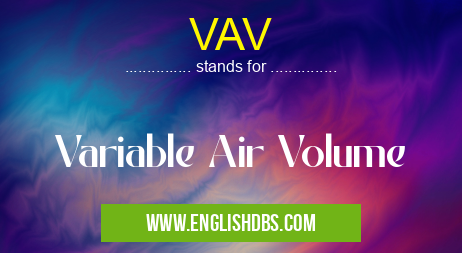What does VAV mean in METEOROLOGY
Variable Air Volume (VAV) is an HVAC system which uses a fan to continually regulate the air flow within an enclosed space. The objective of this system is to prevent the overcooling of a space, while maintaining a comfortable air temperature for occupants. VAV systems are usually controlled using sensors and thermostats. In areas with high humidity, such as factories or industrial settings, VAV can be used to reduce the amount of condensation in the air.

VAV meaning in Meteorology in Academic & Science
VAV mostly used in an acronym Meteorology in Category Academic & Science that means Variable Air Volume
Shorthand: VAV,
Full Form: Variable Air Volume
For more information of "Variable Air Volume", see the section below.
Benefits of Using VAV Systems
The primary advantage of installing a Variable Air Volume (VAV) system is its energy efficiency compared to traditional heating/cooling systems; since each zone can be individually controlled, only those areas that require cooling will use energy as opposed to one large unit that cools an entire building at once regardless of need. This greatly reduces power consumption as well as greenhouse gas emissions since only necessary cooling is used when necessary. Furthermore, since these systems make use of adjustable speed fans they are able to maintain relative humidity levels more consistently than single speed fans reducing overhumidification or underhumidification within a certain area. Finally, not only do these systems help keep spaces comfortable but also quiet; due to their adjustable speed capabilities they run quieter than regular one-speed units making them well suited for buildings which require noise reduction such as healthcare facilities or offices/classrooms.
Essential Questions and Answers on Variable Air Volume in "SCIENCE»METEOROLOGY"
What is a Variable Air Volume (VAV) system?
A Variable Air Volume (VAV) system is an air conditioning technology used for efficiently controlling indoor air temperatures, airflow rates, and humidity. It works by varying the amount of conditioned air flow supplied to each space according to that space’s occupancy needs.
How does a VAV system work?
A Variable Air Volume (VAV) system uses dampers and other control components to adjust the volume of air entering each zone according to its specific temperature requirements. The thermostat settings in each zone are used to control the dampers, sending signals as needed for conditioned air flow. As the need increases, more outside air is drawn in until the desired temperature is achieved in all zones.
How efficient are VAV systems?
VAV systems are highly energy-efficient because they reduce or eliminate overcooling or overheating during times when certain areas of the space are not occupied. This means less energy is consumed than with traditional HVAC systems that maintain constant airflow at all times. Additionally, zoning allows operators to better control temperature in multiple rooms or zones for optimum comfort levels in each area while saving energy overall.
What benefits do VAV systems offer?
VAV systems offer several benefits compared to traditional HVAC systems, including improved occupant comfort, reduced energy usage and costs, greater zoning control, fewer points of failure, and lower maintenance expenses due to fewer parts needing service. Additionally, modern VAV systems can be integrated with automated building management systems for enhanced monitoring and control capabilities.
What industries commonly use VAV systems?
Many industries benefit from using VAV systems due to their versatile design capabilities and efficiency advantages they offer over traditional HVAC solutions. These industries include educational facilities like schools and universities; commercial establishments such as office buildings; hospitality operations like hotels; healthcare organizations like hospitals; manufacturing plants that require climate control; government buildings; and public transportation facilities such as airports.
What type of maintenance do these systems require?
To ensure optimal performance, regular maintenance should be performed on airflow components like dampers and fans within a Variable Air Volume (VAV) system, including cleaning dust from them if needed. Additionally, any other components such as filters should be inspected regularly for signs of wear or damage so they can be replaced or serviced as necessary before causing a breakdown or malfunction of the entire system.
Can I upgrade my existing HVAC system to a VAV one?
Yes - depending on your existing HVAC setup you may be able to upgrade it with some additional components to convert it into a fully operational Variable Air Volume (VAV) system instead. This will usually involve adding ductwork modifications and/or installing additional controllers and sensors so your upgraded system can effectively monitor indoor conditions while delivering tailored airflows according different demands across different zones within your building’s interior spaces.
Are there any disadvantages of using a VAV system instead of more conventional solutions?
The main disadvantage of using a Variable Air Volume (VAV) system versus more conventional HVAC solutions is that it requires additional investment upfront compared with simpler installations since extra equipment is required when setting up this kind of air conditioning network for an entire building or facility structure. Nevertheless this extra cost pays off through improved efficiency which translates into lowered operating expenditure over time—especially when combined with automated controls.
Final Words:
In summary, Variable Air Volume (VAV) systems are becoming increasingly popular among building owners due to their cost-effective nature combined with improved comfort conditions and bespoke solutions tailored for specific applications. By offering greater flexibility regarding individual space requirements in order to not overcool or undercool any given area without compromising on other aerodynamic performance criteria such as airflow rate or noise level VAV has quickly become one of the top choices in climate control.
VAV also stands for: |
|
| All stands for VAV |
